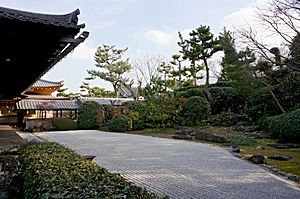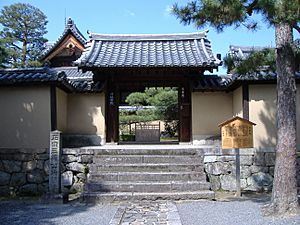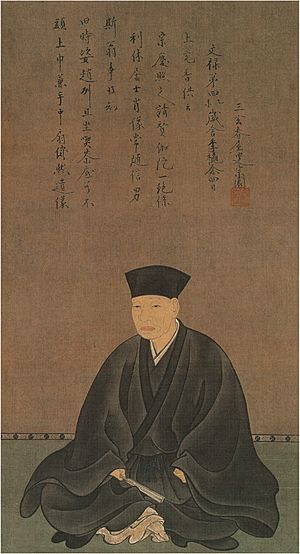Shunoku Sōen facts for kids
Quick facts for kids
Shunoku Sōen 春屋宗園
Kokushi 国師
|
|
|---|---|
| Born | 1529 |
| Died | 1611 |
| Other names | Zen Master Rōgen Tenshin (Rōgen Tenshin Zenji 朗源天真禅師), National Teacher Taihō Enkan (Taihō Enkan Kokushi 大宝円鑑国師) |
| Known for | 111th Head Priest of Daitoku-ji temple. Zen teacher to numerous tea masters.
Associated tea masters: Sen no Rikyū, Furuta Oribe, Ueda Sōko, Kobori Enshū, Sen Dōan, Sen Sōtan, Yabunouchi Jōchi, Imai Sōkyū |
Shunoku Sōen (pronounced "Shunn'oku") was an important Rinzai Zen Buddhist monk in Japan. He lived from 1529 to 1611, during the Azuchi-Momoyama and early Edo periods. He became the 111th Head Priest of the famous Daitoku-ji temple.
Shunoku Sōen received special titles from emperors. Emperor Ōgimachi called him Zen Master Rōgen Tenshin in 1586. Later, in 1600, Emperor Go-Yōzei gave him the highest honor: National Teacher Taihō Enkan.
Contents
Who Was Shunoku Sōen?
Shunoku Sōen was born in a place called Yamashiro Province. He started his journey to become a monk when he was very young.
Early Life and Training
Sōen first trained at Kennin-ji temple under a teacher named Rosetsu Yōha. After that, he became a student of Kōin Sōken at Daitoku-ji temple.
When Kōin Sōken passed away, Sōen finished his training. His new teacher was Shōrei Sōkin, who was the 107th Head Priest of Daitoku-ji.
A Leader at Daitoku-ji Temple
In 1569, Shunoku Sōen became the 111th Head Priest of Daitoku-ji. This was a very important leadership role in the Zen Buddhist world.
Time in Sakai: A New Chapter
After becoming Head Priest, Sōen spent some years in the city of Sakai. He lived at a smaller temple called Yōshun-an, which was part of Nanshū-ji. This was a common tradition for Daitoku-ji Head Priests.
Sakai was a busy merchant city. Famous tea masters like Takeno Jōō and Sen no Rikyū studied Zen at Nanshū-ji. The beautiful karesansui (dry landscape) garden there was designed by Furuta Oribe.
Founding Temples and Gaining Support
In 1580, Sōen started a new temple called Daitsū-an. A rich merchant and tea master named Tsuda Sōgyū helped pay for it. The people of Sakai admired Sōen greatly. In 1583, he became the 3rd Head Priest of Nanshū-ji.
Returning to Kyoto and Sangen-in
Shunoku Sōen moved back to Kyōto in 1589. He lived in other sub-temples of Daitoku-ji, like Daisen-in and Jukō-in. Later, he founded a brand new sub-temple called Sangen-in. Important leaders like Ishida Mitsunari and Asano Nagamasa supported him in building it.
Building New Temples
While at Sangen-in, Sōen also helped build other temples. He founded Zuigaku-ji Temple in Ōmi Province, again with help from Mitsunari. He also founded Yakusen-ji with support from a tea master and merchant named Yamaoka Sōmu.
Shunoku Sōen and the Japanese Tea Ceremony
Shunoku Sōen is very well known for his strong connection to the Way of Tea. He owned many valuable tea items that are now kept at Sangen-in.
In his book of poems and Buddhist sayings, called ‘Ichimoku Kō’, he wrote about famous tea objects. These included special tea jars and tea caddies.
Teaching Zen to Tea Masters
Many famous tea masters studied Zen Buddhism with Shunoku Sōen. He gave them special Buddhist training names. For example, he named Furuta Oribe "Kinpo" and Ueda Sōko "Chikuin." He also taught Kobori Enshū, Sen Dōan, Sen Sōtan, and Yabunouchi Jōchi.
Important Connections and Legacy
Sōen was also close friends with Imai Sōkyū and Sen no Rikyū. In 1589, Sōen led the opening ceremony for the Sanmon gate at Daitoku-ji. Rikyū had paid for this gate to be rebuilt. A few days later, Sōen also led a special ceremony for Rikyū's father.
Rikyū's grandson, Sen Sōtan, lived at Sangen-in under Sōen's care when he was ten years old. Sōen also wrote the special words on the famous portrait of Sen Rikyū by the artist Hasegawa Tōhaku. Sen Dōan asked him to do this.
Shunoku Sōen passed away in 1611 when he was 83 years old. His grave is at Sangen-in.




